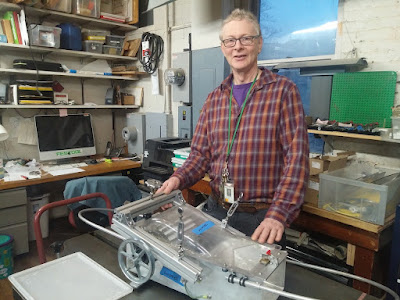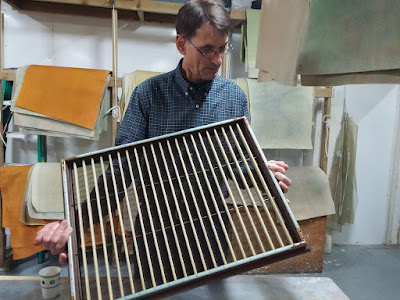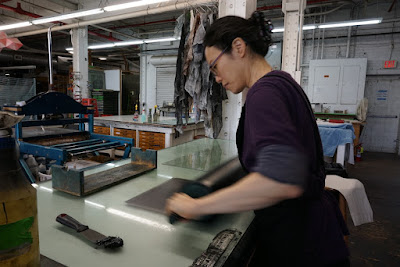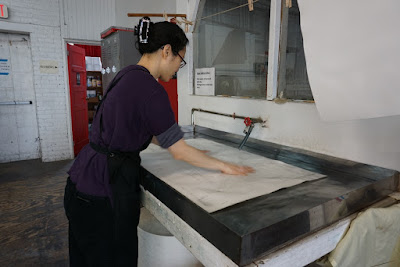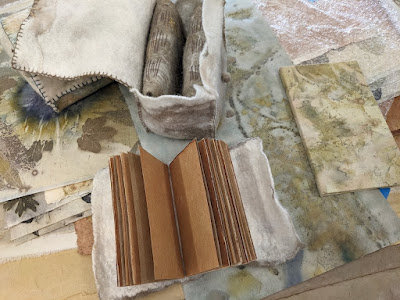In 2016, I applied to the Craft Research Fund with an idea to research and write a book about people who make tools and equipment for hand papermaking. I had been alarmed since 2009 by how few people in Korea were making the bamboo screens to make hanji, and that the numbers kept dropping each time I visited, and wanted to highlight the importance of toolmaking and tools to our craft. Rather than only worrying about cultivating papermakers, I wanted to look at the bigger picture of the ecosystem within which papermakers work, which has to include toolmakers.
Though one of the three jurors thought this was far too niche of a topic, I got the grant, and then was faced with that issue when you write to a grant: I had 5K, which is not enough for this project, but enough to feel buoyed and get started. Also, this grant only supported American craft, so I was only allowed to apply it towards my domestic research. I hit the ground running, and almost immediately met Serge Pirard thanks to Tatiana Ginsberg, and felt like I was going to get this done in good time. Then many gods laughed at my plans.
Nine years later, the book is done! I'll go in order about the fine folks I was able to include:
The
late Helmut Becker was a Canadian whose parents escaped Russia and was part of a huge wave of immigrants who settled the harsh plains of western Canada. He did incredible research and practice in flax for papermaking, but also spent time figuring out how to make moulds and beaters. I tried multiple times to visit him in London but was never able to drive to Canada due to his health, my health, and the trucker protest near Toronto years ago. But I was able to fall back onto our email correspondence and other resources to flesh out this first chapter. Also, when I finally structured the book, I started and ended with Canadians (who were good colleagues/collaborators) and that somehow really satisfied me.

Howie Clark is an early godfather of the American hand papermaking revival of the 20th century, as well as a brilliant engineer, equipment maker, and musician. He could have worked in Detroit for the car industry and still adores cars, having spent a lifetime pulling them apart and putting them together again, drawing them, and living with them. The people who feel this way about cars are the best ones to do this papermaking machine work. I was fortunate to stay with him and his wife Kathryn Clark in Indiana, who were two of the four people who founded
Twinrocker Paper in 1971. They seeded the next powerful generation of papermakers.
One became an apprentice and now has decades of tool and equipment building experience:
Lee Scott McDonald. Originally from Seattle, he has been in Boston for years, and has an entire bevy of experience around design, exhibits, curating, higher ed, volunteer work for papermaking orgs, shop management, and running an entire papermaking supply business. I've been lucky to see him at least a couple of times in Boston (once I called him desperately thinking that I could not open my trunk to unload stuff to teach at MassArt, when it turned out I had just somehow locked it from my glove compartment using a switch I didn't even know existed).
Another beater maker who had many conversations with Howie is
David Reina. I used to
visit his shop in Brooklyn more often, all in my innocent pre-pandemic days. I learned papermaking on two different beaters in grad school and his was one of them. Dave was the child of artists, went to art school, loved cars from a young age and to this day, and had a whole career in toy design before he got into making consistent equipment for hand papermaking: stack dryers, beaters, vacuum tables, and presses. They are highly-sought machines that you will find in many, many professional studios, schools, and private mills. And Dave's wonderful sketch of his hardware-store beater graces the cover of the book.
When I
taught in Vienna years ago, I was able to see one of
Peter Gentenaar's
beaters for the first time. Fortunately, I was able to visit two more of them at his studio in The Netherlands, and finally meet him and his wife Pat. It was magical to see their gardens, beater room, dry studios, home, artwork, and a sliver of their archives. He is an artist who created this lovely beater to help him make the art he needed to, and has it manufactured so other artists can do the same. He has also created big and lasting communities of papermaking, museum programming, and publications. I loved being in a giant mall in Abu Dhabi and
running into his sculptures!
Another name that came up a lot when I was coming up in papermaking was
Mark Lander, an artist from New Zealand who studied, practiced, and taught all kinds of art before he became a papermaking artist. Of course this required making his own machines, because it's not like there were so many to choose from on the South Island. He has a unique business model of building Critters, where the profit from the last buys the materials for the next. Papermakers around the world on a budget love the niche he fills for them, and I've seen his machines from Tasmania to Oberlin—of course along with the ones at his home compound.
Woody has worked for WSW since the 1970s and has been there the longest of any current staff. It took me a while to figure out the parameters of this book to make it manageable. Originally, I wanted to include ALL toolmakers of worldwide papermaking. Then I realized I did not have the language skills, budget, and time to do it. While Woody doesn't make production tools, he has been dedicated to making the physical plant of WSW function, and that includes building out things that only he could imagine, which inspired others in this book. I know this is not a glamorous photo but it's NOT EASY to pin this man down for a glamour shot so I did it when he didn't know I was doing it.
Ron Macdonald was a legend, and I was sorry I never made it to England in time to meet him before he passed away in 2017. He was the final Englishman to work in the British mouldmaking tradition, and grew up doing it because that was his father's business. He was prolific, making almost 10,000 pieces of equipment (his widow Sheila noted he didn't call his products tools, but equipment) before he retired, and sounded like the most humble, generous, hardworking person—and of a past generation. They don't quite make them like this anymore, though fortunately he met someone close to train and pass on his business.
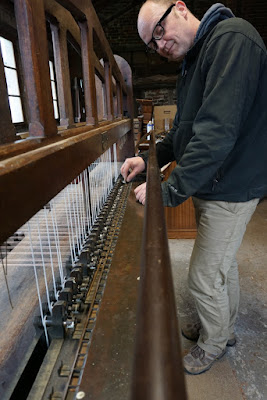
And that was the late Serge Pirard, of Belgium. Today is the first anniversary of his untimely death and it is still hard to accept that he's gone. Serge was so intense in everything he loved: rock climbing, didgeridoo, sailing, and eventually, making traditional British moulds. He immersed himself in these fields and got into moulds while still working a full-time job at Coca-cola, going back and forth to England to study with Ron, and eventually buying Ron's massive loom made in 1889 and inheriting his remaining tools, stock, and clients. We thought that even though the practice hopped over the Channel, that we were good for a bit longer as Serge was still in his 40s and there was time to train folks later.
This loss really hurts, but I was grateful that Serge hosted me in Brussels during my European research, and helped connect me to so many people, drove me around, and fed me handsomely.
The first stop I made after meeting Serge in Brussels and dumping my big bag at his apt was to
Claudine Latron in Lille, France. It was an easy train ride over and she was an impeccable host. She had also studied with Ron, and visited other countries to research looms and mouldmaking, to be able to build the tools that she needed for her practice as a papermaking artist. Originally trained in design, through learning more and more of the book arts, she was introduced to papermaking and mouldmaking at the same time. She successfully petitioned the French government to designate mouldmaking as a national intangible heritage, of which she is a bearer. She has since retired and moved to the south of France, but her first teacher helped her build her own loom to weave mould facings, inspired by the next maker—
Tim Moore is one of America's finest toolmakers, and I think the best mouldmaker we've had. He grew up in Michigan and lives there now in a house and studio he built himself, because he was able to take vo-tech class at the end of high school where the students learned to build one. And because he was always tinkering, making things, and figuring out how stuff worked. He is an impeccable woodworker, but so much more than that, and is always studying, whether reading books and articles or observing mechanisms in the shop. One of the kindest people I've ever met, he is built to work, keeping his hands busy at home, in the studio, and outdoors. He's also one of the most generous, publishing
a detailed blog of pretty much every aspect of mouldmaking that has already served other makers well, after a career of writing for print publications, attending conferences, and teaching others in person and over emails that come from around the world.
Another Michigander is
John Gerard, though he has now spent more of his life in Germany than the US. Trained in art and as a curator, he moved to Berlin in the 1980s and what was supposed to be a year away became a lifetime in his adopted country. He created
a paper studio in Berlin within a larger artist-run studio space that is run today by his former apprentice, Gangolf Ulbricht. Once the Berlin Wall fell, he moved to the countryside and built out an incredible live/work building where he can make paper and pulp paintings, teach classes, make artists' books, and run a
papermaking supply business. Like many in this cohort, he still has the first mould he made and keeps his shop and equipment in pristine shape.
Bob Walp in the Adirondacks in New York grew up in Pennsylvania and had careers in cooking and house building before he discovered book arts. He was so taken by bookbinding, letterpress printing, and papermaking that he went later in life to the University of Alabama for his MFA in book arts and set up shop at home.
Chester Creek Press puts out artists' books where his hand has touched every step of the process. With his skills and temperament, it's no surprise he started to make bookbinding and papermaking tools. Another inveterate tinkerer since childhood, he built his gorgeous house, gardens, and sugar house. He's extremely humble, hard-working, and kind, and I wish more people like him existed in this country in much greater numbers. I visited his beautiful home/shop twice and while I was very upset that a rock cracked my windshield on the way there for my second visit, I was not sorry to have gotten more time to see him and his myriad projects.
I wrote about
Alejandro Geiler years ago for
Hand Papermaking after I learned about this Argentinian man who made paper and moulds. He was also trained in engineering but found his job so boring that after reading about papermaking in a book on printmaking, he decided to try it himself. He has trained people from around the world and is one of the very few who can supply Latin America with solid moulds and expertise. After traveling to Japan for a papermaking conference, he felt a particular affinity to the process and still makes Asian-style paper in his studio. I wasn't able to meet him and I have no Spanish skills, so I was fortunate that
Jocmarys Viruet Feliciano was willing and able to facilitate WhatsApp calls, texts, and emails.

Here's the final Canadian to close this marvelous sandwich! Brian Queen of Calgary is my only subject who has fully embraced newer technology to aid the ancient technology of papermaking. I think he's a genius, but because he didn't do that well in school, he routed into trade school to learn drafting. He went easily from hand drawing to CAD and helped Tim Moore create CAD drawings for mouldmaking to publish and CAD drawings and 3D-printed components for Helmut Becker's beater design. He has been to every single meeting of both papermaking groups since he started his memberships, served as an active volunteer for them, creates the most incredible and generous keepsakes for hundreds of people, and in his retirement from his job creating custom light fixtures, is building book arts programming for the University of Calgary from Helmut's flax seeds, all the way to paper formed on Brian's 3D-printed moulds with custom watermarks.
I don't know why I'm doing this summary of the book, you could simply go buy it (and buy from Oak Knoll, my publisher's distributor, otherwise you will get gouged on discount sites). It includes almost 400 photos and I'm not sure my eyes have yet recovered from selecting and captioning them last year. Cathy Baker of The Legacy Press has stood by me the whole time, even when I called her thinking that I should quit the whole time. I would tell her I'd get it to her x year and then never deliver. During pandemic, I dropped the project entirely because it felt frivolous in the face of what felt like certain death for so many. Everything they say about the second book is true, it's hell. But Cathy never gave up on me, and I am so grateful to her for getting me through the process in record time once I finally submitted my manuscript.
I had a lot of ideas going into why I needed to do this nine years ago:
1. To demonstrate that while hanji is my thing, I know more than only Korean paper, and that my research in Korea makes it easier for me to create these connections from Korean toolmakers to those working in other countries. In fact, the process of building out hanji studios in the US brought me in direct contact with some of these makers, and really brought home how vital and important they are to my work.
2. My approach as a woman would give more context to each person, trying to include (at least wherever my subjects were willing to share their personal lives) that these mostly white men were mostly able to do this work because they had stalwart partners. No solo geniuses, but someone in the background holding down the job with insurance, or cooking meals, or raising kids, or providing emotional and business support.
3. Is no one else worried that almost everyone is a Boomer and where are the young people?? I interviewed three makers younger than me, but none of them ended up doing consistent production toolmaking. Maybe we'll revert back to papermakers making their own equipment, but I feel like, why reinvent the wheel when people have already done it, and so well?
I feel like academia is not where to promote this book, though of course I appreciate their support and speed in making orders. I need to be in vo-tech classes or hanging out with handymen, to show another option for mechanically-minded people who want to do something more off the beaten path. You'll see when you read that being an academic phenom is almost zero what the path of most of this cohort was.
I'll present about the book on September 12 in Minneapolis at the NAHP conference, if you want to learn more and buy a signed copy in person. Otherwise, enjoy the book!




